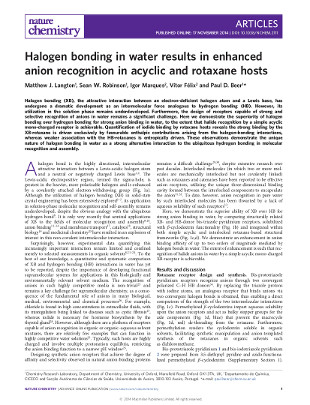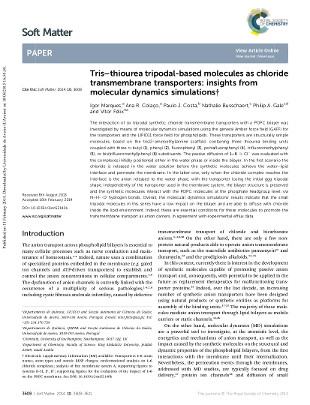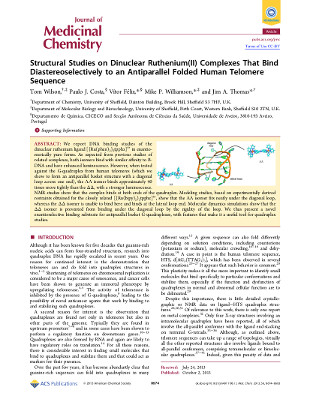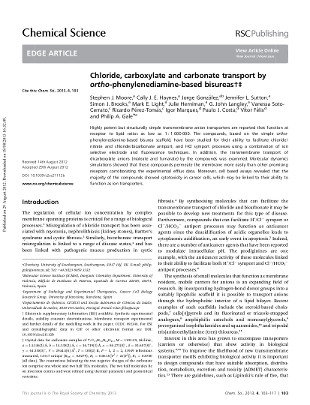Publications
Highlights

Halogen bonding in water results in enhanced anion recognition in acyclic and rotaxane hosts
M. J. Langton, S. W. Robinson, I. Marques, V. Felix and P. D. Beer, Nat Chem, 2014, 6, 1039-1043, Doi: 10.1038/nchem.2111.
Halogen bonding (XB), the attractive interaction between an electron-deficient halogen atom and a Lewis base, has undergone a dramatic development as an intermolecular force analogous to hydrogen bonding (HB). However, its utilization in the solution phase remains underdeveloped. Furthermore, the design of receptors capable of strong and selective recognition of anions in water remains a significant challenge. Here we demonstrate the superiority of halogen bonding over hydrogen bonding for strong anion binding in water, to the extent that halide recognition by a simple acyclic mono-charged receptor is achievable. Quantification of iodide binding by rotaxane hosts reveals the strong binding by the XB-rotaxane is driven exclusively by favourable enthalpic contributions arising from the halogen-bonding interactions, whereas weaker association with the HB-rotaxanes is entropically driven. These observations demonstrate the unique nature of halogen bonding in water as a strong alternative interaction to the ubiquitous hydrogen bonding in molecular recognition and assembly.

Tris-thiourea tripodal-based molecules as chloride transmembrane transporters: insights from molecular dynamics simulations
I. Marques, A. R. Colaco, P. J. Costa, N. Busschaert, P. A. Gale and V. Felix, Soft Matter, 2014, 10, 3608-3621, Doi: 10.1039/c3sm52140k.
The interaction of six tripodal synthetic chloride transmembrane transporters with a POPC bilayer was investigated by means of molecular dynamics simulations using the general Amber force field (GAFF) for the transporters and the LIPID11 force field for phospholipids. These transporters are structurally simple molecules, based on the tris(2-aminoethyl)amine scaffold, containing three thiourea binding units coupled with three n-butyl (1), phenyl (2), fluorophenyl (3), pentafluorophenyl (4), trifluoromethylphenyl (5), or bis(trifluoromethyl)phenyl (6) substituents. The passive diffusion of 1-6 superset Cl(-) was evaluated with the complexes initially positioned either in the water phase or inside the bilayer. In the first scenario the chloride is released in the water solution before the synthetic molecules achieve the water-lipid interface and permeate the membrane. In the latter one, only when the chloride complex reaches the interface is the anion released to the water phase, with the transporter losing the initial ggg tripodal shape. Independently of the transporter used in the membrane system, the bilayer structure is preserved and the synthetic molecules interact with the POPC molecules at the phosphate headgroup level, via N-H...O hydrogen bonds. Overall, the molecular dynamics simulations' results indicate that the small tripodal molecules in this series have a low impact on the bilayer and are able to diffuse with chloride inside the lipid environment. Indeed, these are essential conditions for these molecules to promote the transmembrane transport as anion carriers, in agreement with experimental efflux data.

Structural studies on dinuclear ruthenium(II) complexes that bind diastereoselectively to an antiparallel folded human telomere sequence
T. Wilson, P. J. Costa, V. Felix, M. P. Williamson and J. A. Thomas, J Med Chem, 2013, 56, 8674-8683, Doi: 10.1021/jm401119b.
We report DNA binding studies of the dinuclear ruthenium ligand [{Ru(phen)2}2tpphz](4+) in enantiomerically pure forms. As expected from previous studies of related complexes, both isomers bind with similar affinity to B-DNA and have enhanced luminescence. However, when tested against the G-quadruplex from human telomeres (which we show to form an antiparallel basket structure with a diagonal loop across one end), the LambdaLambda isomer binds approximately 40 times more tightly than the DeltaDelta, with a stronger luminescence. NMR studies show that the complex binds at both ends of the quadruplex. Modeling studies, based on experimentally derived restraints obtained for the closely related [{Ru(bipy)2}2tpphz](4+), show that the LambdaLambda isomer fits neatly under the diagonal loop, whereas the DeltaDelta isomer is unable to bind here and binds at the lateral loop end. Molecular dynamics simulations show that the DeltaDelta isomer is prevented from binding under the diagonal loop by the rigidity of the loop. We thus present a novel enantioselective binding substrate for antiparallel basket G-quadruplexes, with features that make it a useful tool for quadruplex studies.

Chloride, carboxylate and carbonate transport by ortho-phenylenediamine-based bisureas
S. J. Moore, C. J. E. Haynes, J. González, J. L. Sutton, S. J. Brooks, M. E. Light, J. Herniman, G. J. Langley, V. Soto-Cerrato, R. Pérez-Tomás, I. Marques, P. J. Costa, V. Félix and P. A. Gale, Chem. Sci., 2013, 4, 103-117, Doi: 10.1039/c2sc21112b.
Highly potent but structurally simple transmembrane anion transporters are reported that function at receptor to lipid ratios as low as 1 : 1 000 000. The compounds, based on the simple ortho-phenylenediamine-based bisurea scaffold, have been studied for their ability to facilitate chloride/nitrate and chloride/bicarbonate antiport, and HCl symport processes using a combination of ion selective electrode and fluorescence techniques. In addition, the transmembrane transport of dicarboxylate anions (maleate and fumarate) by the compounds was examined. Molecular dynamics simulations showed that these compounds permeate the membrane more easily than other promising receptors corroborating the experimental efflux data. Moreover, cell based assays revealed that the majority of the compounds showed cytotoxicity in cancer cells, which may be linked to their ability to function as ion transporters.
All Publications
2015
• A. Zubi, A. Wragg, S. Turega, H. Adams, P. J. Costa, V. Félix and J. A. Thomas, Chem. Sci., 2015, 6, 4373-4374, Doi: 10.1039/c5sc90026c.
• A. Zubi, A. Wragg, S. Turega, H. Adams, P. J. Costa, V. Félix and J. A. Thomas, Chem. Sci., 2015, 6, 1334-1340, Doi: 10.1039/c4sc02799j.
• M. M. Santos, I. Marques, S. Carvalho, C. Moiteiro and V. Felix, Org Biomol Chem, 2015, 13, 3070-3085, Doi: 10.1039/c4ob02283a.
• P. Pattanayak, D. Patra, P. Brandão, D. Mal and V. Felix, Inorganic Chemistry Communications, 2015, 53, 68-71, Doi: 10.1016/j.inoche.2015.01.018.
• P. Pattanayak, S. P. Parua, D. Patra, C. K. Lai, P. Brandão, V. Felix and S. Chattopadhyay, Inorganica Chimica Acta, 2015, 429, 122-131, Doi: 10.1016/j.ica.2015.02.002.
• C. D. Nunes, P. D. Vaz, V. Felix, L. F. Veiros, T. Moniz, M. Rangel, S. Realista, A. C. Mourato and M. J. Calhorda, Dalton Trans, 2015, 44, 5125-5138, Doi: 10.1039/c4dt03174a.
• T. K. Mole, W. E. Arter, I. Marques, V. Félix and P. D. Beer, Journal of Organometallic Chemistry, 2015, 792, 206-210, Doi: 10.1016/j.jorganchem.2015.04.039.
• D. Das, B. Kumari, S. Lohar, S. Adhikari, A. Sengupta, A. Chattopadhyay, P. Brandao and V. Felix, RSC Adv., 2015, Doi: 10.1039/c4ra14624g.
2014
2013
2012
2011
2010
2009
2008
2007
2006
2005
2004
2003
2002
2001
2000
1995-1999